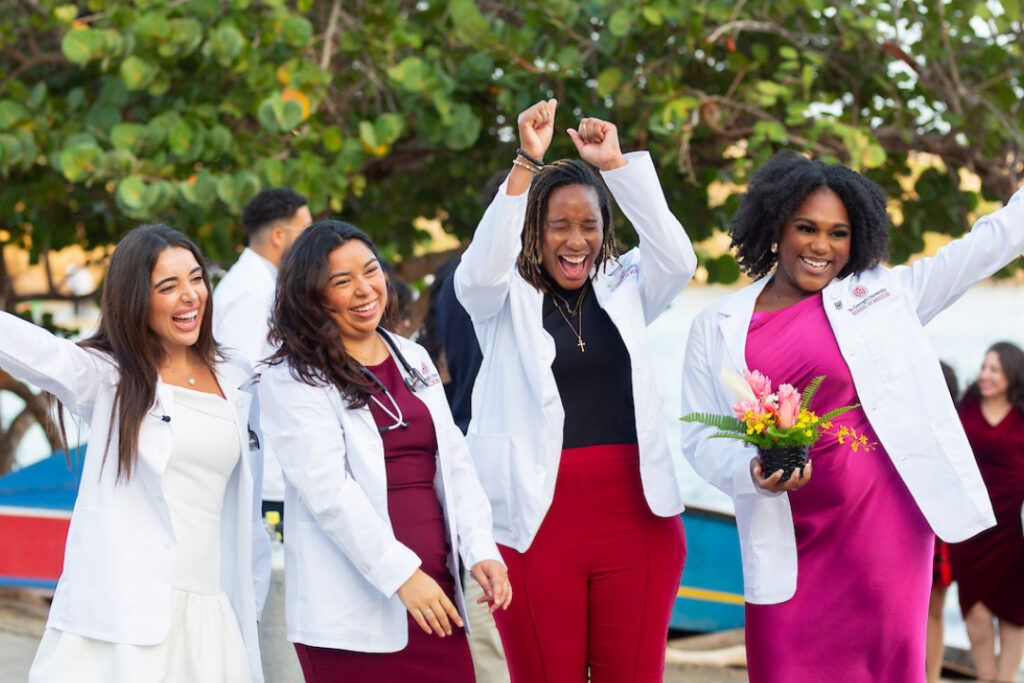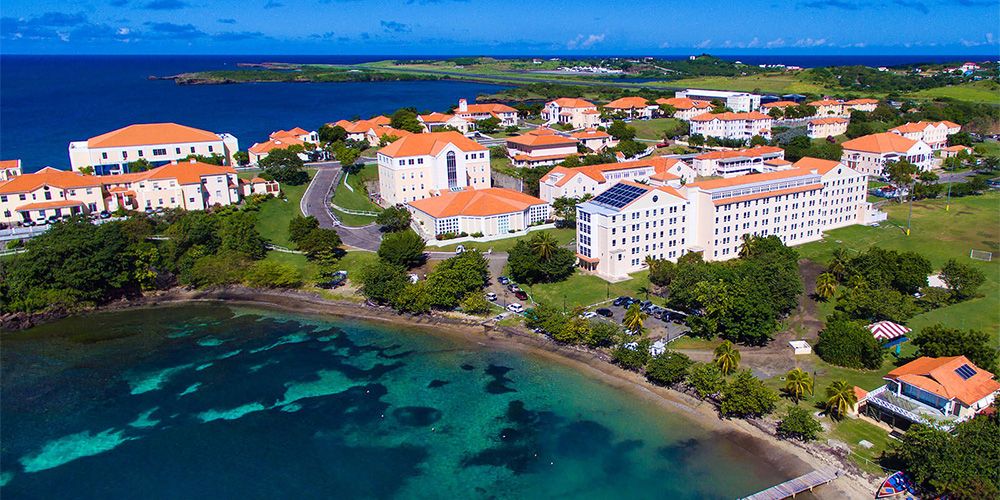Tuition, Fees, and Financial Planning
Get the information you need to plan smartly, apply confidently, and move closer to your dream.
Support for Every Step of Your SGU Investment
Medical education is a valuable investment in your future. SGU understands the financial commitment required to pursue a career in medicine, which is why we offer a variety of financial planning tools, resources, and scholarships to help make your journey more accessible.
With the right support, you can focus on what matters most—your education and training—while we guide you through the financial aspects of your medical school experience.
Your tuition is a significant investment in your future. At St. George’s University, we focus on delivering real value so every dollar you spend aligns with your academic and career success.
Take control of your financial future with tools and guidance to help you plan wisely for medical school.
Explore scholarships that help keep tuition affordable as you pursue your medical career.
Get a clear picture of your total costs, from tuition to living expenses, so you can budget confidently.
Access helpful tools and tips to support your financial planning at SGU

Dr. Ben Kahn
SGU School of Medicine, 2020
Explore Scholarship Opportunities
Consider scholarship opportunities that make medical school more affordable—and your goals more attainable.
Tuition & Administrative Fees
| Basic Sciences (4-year MD Program) | |||
|---|---|---|---|
| Term | Tuition | Administrative Fee | Total |
| Term 1 | $32,937 | $5,818 | $38,755 |
| Term 2 | $32,937 | $5,818 | $38,755 |
| Terms 3/4 | $48,949 | $7,756 | $56,705 |
| Term 5 | $33,293 | $5,818 | $39,111 |
| Total Basic Sciences (Terms 1-5) | $148,116 | $25,210 | $173,326 |
| Clinical Education cost per term | |||
| Term | Tuition | Administrative Fee | Total |
| Term Cost | $35,549 | $4,783 | $40,332 |
| Total Clinical (Terms 1-5) | $177,745 | $23,915 | $201,660 |
| Total Tuition & Administrative Fees for All 4 Years | $325,861 | $49,125 | $374,986 |
For Waterloo Tuition Information Click Here
*SGU bundles most student support services (tech, wellness, student life) into the Administrative Fee. Health insurance is handled separately depending on student eligibility and may vary by location.
Note: There are no administrative fees for the preclinical program.
What Other Costs Should I Expect?
Each year the financial aid office estimates all normal expenses incurred by students in each academic program. In addition to the above tuition and fees, they include estimates for books, transportation, insurance, housing, food and discretionary spending money. This estimate is called the estimated cost of attendance.
University Refund Policy
Students who withdraw or take an LOA, who fail to return from an approved LOA, who are dismissed, or otherwise fail to complete the term for which they are charged, will receive a tuition adjustment of University charges based on a pro rata calculation if the student withdraws during the first 60% of a term.
University charges are prorated based on the percentage of the term that has elapsed. Pro-rata tuition adjustments are calculated based on the number of days the from the start of the term to the date the LOA begins or the withdrawal date. Applicable University charges may consist of tuition, administrative fees, and on campus housing. If a withdrawal takes place after the 60% point, full University charges remain due.
Special refund rules apply to students in their first term of attendance in the MD4 program (Grenada campus). Students who withdraw from the University prior to the 14th week of their first term of attendance, will have their tuition and administrative fees fully refunded. If the student is a federal or private student loan recipient, and the tuition reversal creates an overaward, the overaward amount will be returned to the lender on the student’s behalf.
While a refund may be possible, it is not guaranteed.
- Tuition adjustments may result in either a refund to the student or a balance due to the University.
- For information related to the Housing Cancellation Policy, please consult the University Website.
Students who take a Leave of Absence during a term may apply for a McCord Scholarship by writing a letter to the Office of Financial Aid requesting consideration for this one-time award. A McCord scholarship is a partial tuition scholarship awarded to students who take a Leave of Absence from a term due to compelling personal circumstances beyond the student’s control, causing them to suffer undue financial hardships which affect their ability to pay for their education upon their return. The scholarship is used to help defray all or part of the penalty paid as a result of the withdrawal. The scholarship committee will review the details of the student’s circumstances noted in their application letter and may require further documentation before determining eligibility for the scholarship. These awards are grants-in-aid and do not have to be repaid.
Return of Title IV Financial Aid
In accordance with US Federal Title IV Regulations (34 CFR 668.22), St. George’s University is required by the Higher Education Act to recalculate the eligibility for federal Title IV aid for students who withdraw or take a Leave of Absence (LOA), up to 60% of a term. When a student withdraws or takes a leave during the term, the amount of Title IV program assistance that a student has earned up to the point of withdrawal is determined on a pro-rata basis. The amount earned is based on the number of days the student completes in the term as of the withdrawal date or Leave of Absence begin date for official withdrawals and the last date of documented attendance at an academically related activity as determined by SGU, for unofficial withdrawals. Scheduled breaks of five days or more are excluded from the calculation. For students who officially withdraw from SGU, the withdrawal date is the date the student began the withdrawal process.
There are special Title IV withdrawal rules for a term that has modules (courses that do not span the entire length of the term). This would apply to a student’s clinical terms and MD Basic Science Term 3/4. A student is not considered withdrawn for Title IV purposes if at the point of ceasing participation the student:
- Successfully completes 49% of the days in the term,
- Earned half-time credits
- 5-term credits for MD Basic Science terms
- 6-term credits for Vet Basic Science terms
- 8 credits for Clinical terms or;
- Completes all of the program requirements and is considered a graduate.
For days to count toward the 49% requirement, the student must receive a passing grade in at least one course that spans an entire module. If the student meets any of these conditions, the student is not considered to be withdrawn for Title IV purposes, and all aid received for the term is retained. If grades for the term are not received within 30 days from the date the University determines the student ceased participation, the student will be processed as a Title IV withdrawal. If a passing grade is received at a subsequent point, the University will reevaluate the student’s withdrawn status and may reverse the Title IV refund calculation and refund payments. Though Title IV aid is generally posted to a student’s account at the start of each term, these funds are earned as a student progresses through the term. Students who stop attending before completing more than 60% of a term will have their Title IV aid recalculated based on the percentage of the term they completed. If a student withdraws or takes a leave during the term, the amount of Title IV program aid earned up to the withdrawal date is determined by a specific pro-rata formula of days completed to the total days in the term and is called the return to Title IV funds (R2T4) calculation. For example, if a student completes 30% of the days in the term, the student would earn 30% of the Title IV aid originally scheduled for the term and the 70% of unearned funds is returned. Once more than 60% of the term is completed, all the Title IV aid the student was scheduled to receive for the term is earned. However, some earned Title IV aid may not be eligible for disbursement due to other eligibility requirements.
In compliance with federal regulations, the Financial Aid Office will perform the R2T4 calculation within 30 days of the student’s date of determination (DOD) of withdrawal and funds will be returned to the appropriate federal aid program within 45 days of the DOD. As part of the R2T4 calculation process, an evaluation is done to determine if aid was eligible to be disbursed but was not disbursed as of the withdrawal date. If a student received less Title IV aid than the amount earned, a student may be eligible to receive those additional funds as a post-withdrawal disbursement. If a student received more assistance than earned, the excess funds must be returned by the school and/or the student. Students who are eligible for a post-withdrawal disbursement are notified of their eligibility within 30 days of determining the student’s date of withdrawal and the student must give permission to make the disbursement within 14 days of this email notice. A student may choose to decline some or all of the post-withdrawal disbursement, to avoid additional debt. If the student received Title IV aid in excess of what was needed to pay tuition and fees, a portion of the unearned funds may be considered an overpayment and due to be repaid from student instead of the institution. An overpayment exists when the excess unearned Title IV funds are to be returned in part by the institution and in part by the student because each party received a portion of the unearned funds according to the R2T4 calculation. For any loan fund overpayment that a student is required to return, repayment will be in accordance with the terms of the promissory note. That is, scheduled payments should be made to the holder of the loan over the term of repayment.
Unearned Title IV funds held by the institution are returned within 45 days of the date of determination of withdrawal in the following order:
- Federal Direct Unsubsidized Loan
- Federal Direct Grad PLUS Loan
The requirements for the R2T4 policy calculation described above are separate from the calculation of the University’s Refund Policy, which determines the amount of tuition and fees a student is charged upon withdrawal from a term. Therefore, a student may owe unpaid institutional charges that were once paid by Title IV aid which were deemed unearned by the R2T4 calculation. The student will receive a notice from the University, which details the outcome of both the R2T4 policy and the University’s Refund policy and information on any returns that were paid or balance due. If you have questions about your Title IV program funds, you may contact the Office of Financial Aid directly, or call the Federal Student Aid Information Center at 1-800-4-FEDAID (1-800-433-3243). TTY users may call 1-800-730-8913. Information is also available online at studentaid.ed.gov.
Official and Unofficial Withdrawal
If a student wishes to officially withdraw from the University, he or she must complete and submit the appropriate Withdrawal Form through the University Portal. If a student stops attending classes or clinical rotations and has not provided a Withdrawal Form, notified the Registrar of a withdrawal or requested a Leave of Absence, he/she will be unofficially withdrawn from the University through the Administrative Withdrawal process.
Leave of Absence (LOA)
Students who must interrupt their studies for part of a term or longer, should submit their LOA requests electronically via the link on the University Portal and are required to receive written approval for a Leave of Absence (LOA) from the Office of the Dean of Students. These forms will require a reason for the LOA, the student’s signature, and a date. Under federal regulations, a LOA in the Basic Science terms is treated the same as a withdrawal for Title IV purposes. In the clinical terms, a LOA must be requested and approved in advance, may not exceed 180 days in any 12 month period. Clinical LOA’s that do not meet these conditions are treated the same as a withdrawal for Title IV purposes.
It is the responsibility of the students to ensure he/she receives written approval prior to leaving the University. Once the form is electronically submitted, the student receives an immediate email, confirming receipt of the request and the request is automatically sent to the Office of the Dean of Students and Registrar’s Office. Each school has its own regulations regarding how withdrawn courses are noted on the transcript. Students are advised to seek counseling from the Dean of Students and their Faculty Advisors prior to withdrawal. If a student has had a prior Leave of Absence during his/her course of study, needs an extension, or the student has already repeated coursework, the Dean of Students may need to seek approval from the student’s Academic Dean. A request for an extension can be made in the comments section of the LOA form. Requests must include an explanation of special circumstances.
Students who take an LOA during a term may apply for a McCord Scholarship by contacting the Office of Institutional Student Financial Assistance at FAIDScholarships@sgu.edu requesting consideration for this one-time award. A McCord scholarship is a partial tuition scholarship awarded to students who take a Leave of Absence from a term due to extenuating circumstances beyond the student’s control, causing them to suffer undue financial hardships which affect their ability to pay for their education upon their return. The scholarship is used to help defray all or part of the penalty paid as a result of the withdrawal. These awards are grants-in-aid and do not have to be repaid.
MD Repeated Coursework Tuition Policy for all students:
- All MD4 students in Terms 1 -5 will be charged full tuition and fees for all courses/Terms including repeated courses/Terms due to failure, returning from a leave of absence (LOA), or choosing the credit remediation (CR) option.
- If a student repeats a course/Term due to a failure or taking a CR and the student is subsequently unsuccessful in the repeated course, the tuition charges for the repeated course will be reversed. The student is responsible for administrative fees based on the standard refund policy.
- Unsuccessful is defined as either a failure in the course or withdrawing from the university.
- If the student is a federal or private student loan recipient, and the tuition reversal creates an overaward, the overaward amount will be returned to the lender on the student’s behalf.
- If a student repeats a course/Term due to a failure or taking a CR and the student is subsequently unsuccessful in the repeated course, the tuition charges for the repeated course will be reversed. The student is responsible for administrative fees based on the standard refund policy.
- Students receiving scholarships should consult the Office of Financial Aid (faid@sgu.edu)
- Students who have questions regarding the tuition refund/repeated coursework policy should contact the Office of the Bursar (bursar@sgu.edu).
Effective for all MD students:
Students who take a Leave of Absence within the term will be charged the published tuition rates when they return to repeat the coursework. Students who take a Leave of Absence during a term may apply for a McCord Scholarship. A McCord scholarship is a partial tuition scholarship awarded to students who take a Leave of Absence from a term due to compelling personal circumstances beyond the student’s control.The McCord Scholarship is designed to assist students with the loss in tuition suffered from repeating a term due to an urgent medical leave of absence or extenuating circumstance. Eligible students may contact the Office of Instituitional Student Financial Assistance at FAIDScholarships@sgu.edu to apply.
Preclinical Tuition Repeater Policy
Effective for students repeating coursework as of January 2023:
Preclinical students (5/6/7 Year MD Pathway) who repeat a course due to failure or as required remediation will be charged the published tuition rates when they return to repeat the coursework.
Policy is subject to change.
Financial Planning

US Citizens and Permanent Residents
Begin with a Comprehensive Plan
St. George’s University (SGU) medical students rely on a combination of federal loans, scholarships, and careful budgeting to finance their education. Developing a personalized financial strategy is essential for covering tuition, fees, and living expenses while minimizing unexpected costs. The Office of Financial Aid at SGU serves as a valuable resource, guiding students through each step of the financial planning process—from acceptance through to graduation.
US Federal Student Loans
US Federal Student Loans are only available for the Four-Year MD portion of all dual degrees.
St. George’s University participates in the William D. Ford Federal Direct Loan Program. These loans are available to US students who are US citizens or US Permanent Residents in the School of Medicine who are or have been enrolled in the Basic Science portion of their program in Grenada. (As of July 1, 2011, students in SGU/NU Program are not eligible for the Federal Direct Loan Program.)
The William D. Ford Federal Direct Loan Program consists of the Federal Direct Unsubsidized Loan and Federal Direct Graduate PLUS Loan. The maximum loan amount for which a student is eligible may not exceed the cost of attendance (as defined by St. George’s University) less any other financial aid received for the academic period in which the student is enrolled. Eligible students can borrow up to $20,500 per academic year from the Federal Direct Unsubsidized loan not to exceed an overall aggregate amount borrowed of $138,500. The Federal Direct Graduate PLUS loan program is used to bridge the gap between the Unsubsidized Loans and the remaining cost of attendance. Students must not have an adverse credit history in order to qualify for a Federal Direct Graduate PLUS loan. The Direct PLUS loan does not have an aggregate limit.
Students may choose to pay the interest while attending school. If allowed to accrue, interest will be capitalized (added to the principal balance) at the beginning of the repayment period. The interest rate for all Unsubsidized loans with a first disbursement on or after July 1, 2024 is fixed at 8.083%. The interest rate for all Grad PLUS loans with a first disbursement on or after July 1, 2024 is fixed at 9.083%. The student will also be required to pay a pre-disbursement loan origination fee on the amount borrowed. Effective October 1, 2021 the origination fee will be 1.057% on Unsubsidized loans and 4.228% on Direct PLUS loans. These fees will be deducted from the amount borrowed and will be reflected in the disbursements issued to the student’s account.
Loans are typically processed for an academic year and are disbursed in two installments. Disbursements typically occur 10 days before the start of an academic term. For example, if a student requests a $20,500 Federal Direct Unsubsidized Loan, the Department of Education will release half the requested amount, less loan fees, any applicable fees for the first term of the academic year, and release the second half of the approved amount (less fees) 10 days before the start of the second term. Loan funds are disbursed to the student’s account and if a credit balance is created, the credit will be refunded to the student by check or direct deposit, typically within 10 business days.
Under the Direct Unsubsidized and Graduate PLUS loan programs, the student is responsible for all accruing interest and may choose to repay the interest while in school or defer it until repayment begins. Upon graduation, a grace period is applied automatically to your Federal Direct loans. The grace period is a one-time 6-month period during which no payments are required, although interest will continue to accrue on these loans. If a student ceases to be enrolled at least half-time (withdraws or takes a leave of absence), the 6-month grace period would apply in most circumstances. Students who withdraw, drop below five (5) credits or graduate must complete online Exit Counseling if they have received a Federal Graduate PLUS loan. The Exit Counseling will provide you with your federal loan history and will inform you of your repayment options.
Repayment on these loans begins 6 months after the student ceases to be enrolled at least half-time. The amount of your monthly repayment is calculated based upon the total amount that you have borrowed, as well as the repayment plan that you choose. Visit the Federal Student Loan Repayment Plans page at studentaid.gov to learn about repayment plans and to use the Loan Simulator. The Loan Simulator will help to find the best repayment strategy for you.
Students can apply for US federal loans by completing the Free Application for Federal Student Assistance (FAFSA) at studentaid.gov. When completing the FAFSA, be sure to enter the appropriate school code. The SGU School of Medicine federal school code is G22333. Students will also need to complete Entrance Counseling and Master Promissory Notes in order to complete the application process.
To receive Direct Loans, recipients must be either permanent residents or citizens of the United States, be enrolled in the 4 Year MD program at least half-time, maintain satisfactory academic progress, and not be in default on any prior U.S. government-guaranteed loan. These guidelines are subject to statutory and/or regulatory changes in the U.S. Higher Education Act and the Title IV Program Regulations. For details on how to apply click here.
Students borrowing federal loans can complete the Title IV Authorization form online through their SGU Student Self Service account. This will allow the Office of the Bursar to apply your federal loan proceeds toward non-tuition charges such as books and health insurance in order to satisfy your student account.
Borrowers Rights and Responsibilities
Private Educational Loans
Private educational lenders in the United States offer students at St. George’s University alternate loans. US Students can apply for these loans to meet all or part of their cost of attendance. Students who are considering the SGU/NU Program can explore these options. Some lenders may also offer private loan programs for parents, guardians, sponsors, or other individuals who wish to borrow on behalf of the student to help fund their education. These private loan programs are all credit-based and are offered only to borrowers who have a satisfactory credit history as determined by the lender. The loans may have a fixed or variable interest rate that is tied to an index, such as LIBOR or PRIME, plus a margin. The interest rates and fees you pay on a private student loan are based on your credit score and the credit score of your cosigner, if applicable. These loans have repayment terms that begin following graduation or withdrawal from school and may be able to be extended up to 25 years.
The Office of Financial Aid at SGU provides extensive financial aid counseling services to students in order to help them understand the eligibility requirements, terms and conditions.
St. George’s University does not prefer, recommend, promote, endorse, or suggest any lenders. You are not required to borrow from any of the lenders appearing on these lists and there is no penalty for selecting a different lender, if available.
Financial Aid Loan Code of Conduct
Eligibility Requirements:
- U.S. citizen or permanent resident
- Enrolled in SGU’s MD program
- Maintain satisfactory academic progress
- No default on prior federal loans
How to Apply:
- Complete the FAFSA and enter SGU School of Medicine federal school code: G22333.
- Submit required documents to the Office of Financial Aid
- Meet with a financial aid counselor to customize your plan
Scholarships
Medical school is a significant investment in your future. SGU offers a variety of scholarship opportunities that can help you achieve your dream of becoming a doctor. Each SGU award is specifically tailored to recognize and reward exceptional qualities in aspiring medical professionals. From academic merit scholarships to scholarships that recognize community service, achievements in research, a desire to work with populations that are traditionally underserved in medicine, and service in the healthcare sector, SGU is committed to fostering a diverse and talented community of future doctors.
All students admitted to the Four-Year Doctor of Medicine (MD) or to one of the Seven-Year, Six-Year or Five-Year Medical Degree Tracks are automatically reviewed for academic and other scholarship type eligibility at the time of acceptance.
Veteran’s Benefits
St. George’s University is a participant in the Department of Veteran Affairs Educational Programs. Only students who were a uniformed service member, veteran, veteran’s dependent, surviving spouse, or child of a deceased veteran, and are registered in the MD or DVM Program are eligible for VA Benefit.
VA Education Programs
The following is a list of Veteran Affair benefit programs that the SGU MD or DVM program is eligible for:
- Chapter 30 – Montgomery GI Bill®– Active Duty
- Chapter 32 – Veterans Educational Assistance Program (VEAP)
- Chapter 33 – Post 9/11 GI Bill®
- Chapter 34 – GI Bill®
- Chapter 35 – Dependents Educational Assistance program DEA
- Chapter 1606 – Montgomery GI Bill® – Selective Reserves
- Chapter 1607 – Reserve Educational Assistance Program REAP
Initiating Veterans Benefits at SGU
Submit the appropriate application form listed below to the VA:
- Student should compare VA education benefits and review payment rates by utilizing the Comparison Tool.
- Apply for benefit through the VA using the Veterans Online Application (VONAPP).
- Submit Certificate of Eligibility to an SGU School Certifying Official (see contact information below).
Receiving Veterans Benefits at SGU
After you have initiated your Veterans Benefits at SGU, a School Certifying Official will contact you at the beginning of each term. Once your enrollment has already been certified for a term in the current VA year, you will not be automatically certified for another term, unless you request otherwise. You will receive an automatic electronic notification from the VA after your enrollment has been certified. Payment of benefit can take up to two to four weeks after it is certified. Eligibility and payment amounts are determined by the VA and not by SGU. Please access visit the VA’s Rate Tables for the various benefit programs.
Contact: St. George’s University Certifying Official/Financial Aid Counselor
Phone: (631) 665-8500 Ext. 1675
Email: faid@sgu.edu
For more information please visit:
- http://www.gibill.va.gov/
- http://www.gibill.va.gov/Vet_Info/OS_TrngV.htm
- https://studentaid.ed.gov/sa/sites/default/files/military-student-loan-benefits.pdf
- http://benefits.va.gov/gibill/foreign_school_information_for_students.asp
Financial Planning Support
SGU’s team of financial aid professionals can help you:
- Guide through the federal loan process
- Build a realistic budget
- Understand repayment options
- Make confident funding decisions
Canadian Citizens and Permanent Residents
For Canadian Citizens
St. George’s University offers financial aid counseling to help meet the diverse needs of the student population. The university’s comprehensive outreach to governments and private lending institutions combined with the university’s own financial resources, have created a unique offering of loans and other financing options for our students worldwide. St. George’s University is approved by the Canadian Ministry of Education, entitling most students to the ability to receive Canadian Federal and/or Provincial Loans. To supplement the financing of their education, students usually apply for a professional line of credit available through the banks in Canada. St. George’s University is committed to ensuring that students are aware of all their financial aid options and as such we have designated counselors to work directly with you to address your questions and needs.
Office of Institutional Student Financial Assistance
ISFA@sgu.edu
Begin with a Comprehensive Plan
SGU students from Canada fund their education through a combination of:
- SGU Scholarships
- Professional Lines of Credit
- Federal & Provincial Loans
- Family Contributions
- SGU Institutional Loans
- SGU Exchange Rate Lock
Scholarships
SGU offers a variety of merit- and service-based scholarships to recognize and support high-achieving, community-driven, and academically outstanding students.
- Automatically considered upon acceptance
- Available for Four-Year MD and Five-, Six-, and Seven-Year Medical Pathways
- Award types include academic merit, community service, healthcare commitment, and more.
Professional Student Lines of Credit
Many Canadian medical students supplement their education with lines of credit offered by leading Canadian banks. These loans offer:
- Higher borrowing limits for medical students
- Interest-only payments during school
- Flexible repayment terms post-graduation
- Sample Banks: RBC, Scotiabank, TD, CIBC, BMO
- Federal & Provincial Student Loans
- Canadian students may qualify for government-funded loans and grants, including:
- Canada Student Loans Program (CSLP)
- Provincial aid programs like OSAP (Ontario), AFE (Quebec), StudentAid BC, and others
How to Apply:
- Visit your province’s student aid website
- Submit an application each loan period
- Provide SGU enrollment verification if requested
SGU is a recognized international institution with multiple Canadian provinces.
Family Contributions
Plan Together, Invest in Your Future
Family support can help reduce overall borrowing. Discuss options for shared contributions, RESP usage, or co-signing on student lines of credit.
SGU Institutional Loans
Need help bridging a gap in your funding? SGU offers limited institutional loans based on individual need. Contact the Office of Institutional Student Financial Assistance to check eligibility and terms.
SGU Exchange Rate Lock
Predictable Costs for Canadian Students
- Lock your USD/CAD tuition exchange rate from entry to graduation
- If exchange rate improves, you benefit from the better rate
Confidential Financial Statement Canadian Doctor of Medicine Program
Confidential Financial Statement Canadian Preclinical Program
International Students
Begin with a Comprehensive Plan
Financing your medical education at SGU involves a combination of scholarships, personal loans, family contributions, and strategic financial planning. Our Office of Institutional Student Financial Assistance is dedicated to assisting you throughout this process, from acceptance through to graduation.
Scholarships for International Students
All International (non-US and non-Canadian) students are eligible to be reviewed for scholarships and need-based bursaries. International Students will need to submit a Confidential Financial Statement (CFS) to be considered for an award. Contact your admissions representative for additional details and if you have any questions while completing the CFS.
Confidential Financial Statement for the Doctor of Medicine Program Guidelines
International students may explore personal loan options through banks or financial institutions in their home countries. It’s advisable to consult with financial advisors to identify suitable loan products.
Family Contributions
Many students receive financial support from family members to cover tuition and living expenses. Discussing and planning contributions early can alleviate financial pressures.
SGU Institutional Loans
SGU offers limited institutional loans to qualified students. These loans are designed to assist with financial gaps and are available on a case-by-case basis. Contact your Admissions representative for more information.
Contact Information
Office of Institutional Student Financial Assistance
Email: ISFA@sgu.edu
Phone: +1 (631) 665-8500 ext. 1232
Resources
AAMC Loan Repayment, Forgiveness, Scholarship, and Other Programs Database
This searchable database provides detailed information about programs available to medical and health professions students. This compilation is not exhaustive. We encourage you to speak with your financial aid counselor for additional information.
Loan Repayment/Forgiveness/Scholarship and Other Programs Database
Public Service Loan Forgiveness (PSLF)
This federal program was established by Congress in 2007 and offers loan forgiveness for borrowers meeting all required eligibility requirements.
Explore PSLF
Program Summary
The PSLF program provides tax-free loan forgiveness for a borrower’s remaining Direct Loan balance after the borrower makes 120 qualifying monthly payments while repaying their loans under a qualifying repayment plan, and while working full time for a qualifying, public service employer.
Program Requirements
- Be employed full time by a qualifying employer.
- Have eligible Direct Loans (or consolidate non-eligible loans into a Direct Consolidation Loan to make them eligible).
- Repay loans under a qualifying income-driven repayment plan or the Standard plan. Borrowers would not want to be in the Standard plan the entire time of repayment because there would be nothing left to be forgiven at the end of the 10-year term.
- Make 120 qualifying monthly payments. Payments do not need to be consecutive.
Recent Improvements to PSLF
Improvements were recently made to the PSLF program. Some of the improvements include qualifying payment credits for consolidated loans, changes to the definition of full-time employment, some deferments and or forbearances allowing qualifying payments, and the ability to make lump sum (or prepayments) up to 12 months till the next recertification of income.
Residency Programs and PSLF Eligibility
The best way to find out if a residency program will qualify for PSLF is to ask during the residency interview.
The answer may help you determine if you want to pursue a residency position with that program, especially if PSLF is a priority. The PSLF employer search tool through the Federal Student Aid website is a tool that can help with determining if a potential employer may qualify as an eligible employer.
Completing and Submitting the PSLF Form
Once you begin residency, you can complete, sign, and submit the PSLF form digitally using the PSLF Help Tool, or by manually downloading a PDF of the PSLF form. You should complete this form annually and
when, or if, you change employers. Completing the form indicates interest in the PSLF program, and it allows the Department of Education to verify employment eligibility and track PSLF payment counts. Borrowers who are interested in PSLF should also keep records of their payments. They should verify that their payment count matches the payment count reported by the Department of Education (DOE). If there are ever any discrepancies, the borrower should contact the DOE immediately.
Once a borrower makes 120 payments, the DOE will confirm PSLF eligibility and forgive the remaining Direct Loan balance. The borrower will want to continue to work for their qualifying employer and make
payments until they receive notification that they’ve officially made 120 qualifying payments. Borrowers can verify their qualifying payment total by logging into studentaid.gov and by viewing their loan details. This information can also be found on the borrower’s most recent billing statement.
For updates and changes to the PSLF program, be sure to visit studentaid.gov and also pay close attention to any correspondence you receive from the Department of Education.
Connect with SGU’s Office of Financial Aid
For personalized support and step-by-step guidance, financial aid counselors can be reached Monday through Friday from 9 am–5 pm (Eastern):
US/Canada Toll-free: 1 (800) 899-6337 ext. 1232
Worldwide: +1 (631) 665-8500 ext. 1232
Email: faid@sgu.edu
Fax: +1 (631) 666–9162
From Dr.eam To Doctor
Learn more about our MD program and tracks
Every aspect of our MD program and tracks are intentionally designed to support you on your path to becoming a physician.
Flexible Start Dates: Choose from multiple entry terms in April, August, or January to begin your medical education at your convenience.
Average of 2020, 2021, 2022, 2023 and 2024 residency placement rates. Residency placement rate is defined as the total number of students/ graduates who obtained a US residency divided by the total number of students / graduates who applied to a US residency program in a given year as of October 2024.
Program and Track Highlights
- Global Recognition: SGU’s School of Medicine has been continuously accredited for decades, enabling our students to be eligible to practice in the US.
- Clinical Training: 85+ hospitals and health systems in the United States, Canada, and the United Kingdom offer clinical and ambulatory training and support
- Legacy of Excellence: Join the network of over 25,000 graduates* who have impacted healthcare worldwide.
*Based on the number of students who have completed the Doctor of Medicine program from 1981-2025.

Connect With Us.
- Learn more about our MD program and tracks
- Receive priority invitations to our prospective student events
We will be in touch soon, but if you have questions now, email us at admissions@sgu.edu




